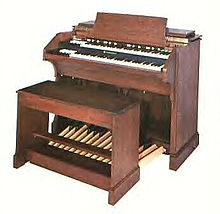
Back أرغن هاموند Arabic Арган Хаманда Byelorussian Арган Гаманда BE-X-OLD Orgue Hammond Catalan Hammondovy varhany Czech Hammondorgel Danish Hammondorgel German Hammond-orgeno Esperanto Órgano Hammond Spanish Hammondi orel Estonian
| Hammond organ | |
|---|---|
 A Hammond C-3 organ | |
| Manufacturer | The Hammond Organ Company (1935–1985) Hammond Organ Australia (1986–1989)[1] Hammond-Suzuki (1989–present)[2][3] |
| Dates | 1935–1975 (tonewheel models) 1967–1985 (transistor models) 1986–present (digital models) |
| Price | $1,193 (Model A, 1935)[4] $2,745 (Model B-3, 1955)[5] |
| Technical specifications | |
| Polyphony | Full |
| Oscillator | Tonewheel |
| Synthesis type | Additive |
| Effects | Vibrato, chorus, reverb, harmonic percussion |
| Input/output | |
| Keyboard | 2 × 61-note manuals, 25-note pedals (consoles) 2 × 44-note manuals, 13-note pedals (spinets) |
| External control | Amphenol connector to Hammond Tone Cabinet or Leslie speaker |
The Hammond organ is an electric organ invented by Laurens Hammond and John M. Hanert[6] and first manufactured in 1935.[7] Multiple models have been produced, most of which use sliding drawbars to vary sounds. Until 1975, Hammond organs generated sound by creating an electric current from rotating a metal tonewheel near an electromagnetic pickup, and then strengthening the signal with an amplifier to drive a speaker cabinet. The organ is commonly used with the Leslie speaker.
Around two million Hammond organs have been manufactured. The organ was originally marketed by the Hammond Organ Company to churches as a lower-cost alternative to the wind-driven pipe organ, or instead of a piano. It quickly became popular with professional jazz musicians in organ trios—small groups centered on the Hammond organ. Jazz club owners found that organ trios were cheaper than hiring a big band. Jimmy Smith's use of the Hammond B-3, with its additional harmonic percussion feature, inspired a generation of organ players, and its use became more widespread in the 1960s and 1970s in rhythm and blues, rock, reggae, and progressive rock.
In the 1970s, the Hammond Organ Company abandoned tonewheels and switched to integrated circuits. These organs were less popular, and the company went out of business in 1985. The Hammond name was purchased by the Suzuki Musical Instrument Corporation, which proceeded to manufacture digital simulations of the most popular tonewheel organs. This culminated in the production of the "New B-3" in 2002, a recreation of the original B-3 organ using digital technology. Hammond-Suzuki continues to manufacture a variety of organs for both professional players and churches. Companies such as Korg, Roland, and Clavia have achieved success in providing more lightweight and portable emulations of the original tonewheel organs. The sound of a tonewheel Hammond can be emulated using modern software audio plug-ins.
- ^ "Marmon Group sells Hammond Organ rights". Chicago Sun-Times. January 3, 1986. Archived from the original on June 11, 2014. Retrieved July 31, 2013.
- ^ Faragher 2011, p. 14.
- ^ "Hammond XK-3 STORY: 3. History—locus of Hammond Combo Organ" (in Japanese). Hammond Suzuki Co., Ltd. April 22, 2005. Archived from the original on July 15, 2009.
- ^ Vail 2002, p. 68.
- ^ Vail 2002, pp. 66, 69.
- ^ Bush & Kassel 2006, p. 168.
- ^ Corbin 2006, p. 151.